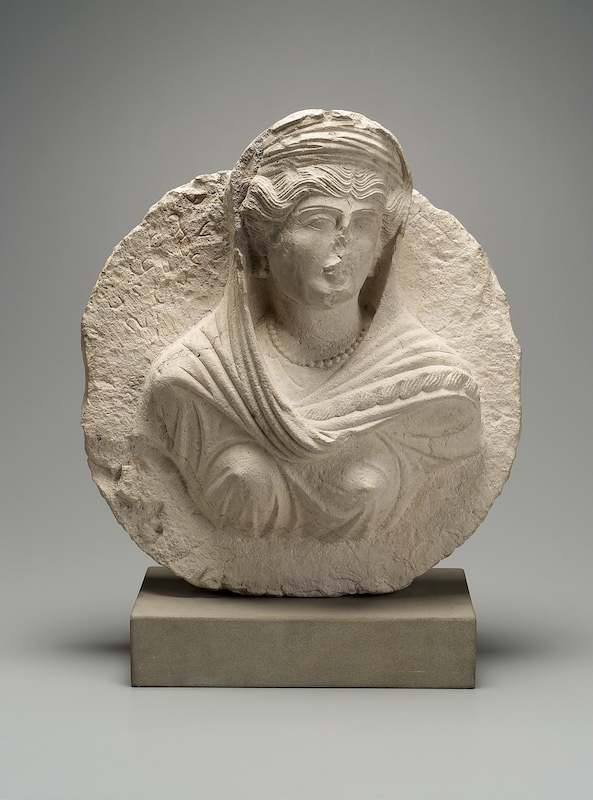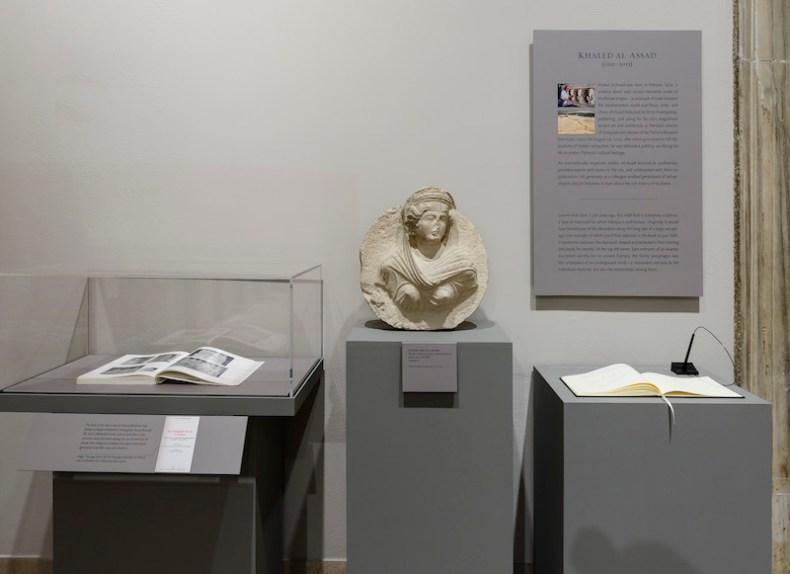The days that followed ISIS’s savage murder of the distinguished and widely admired archaeologist Khaled al-Asaad last August were filled with shock and outrage. At the Museum of Fine Arts, Boston, which possesses a world-class collection of ancient art, including 10 funerary sculptures from Palmyra, a group of colleagues sat down to discuss ways we could respond to this horrific crime.
While no one at the MFA had a personal connection to al-Asaad, he was a fixture in the international archaeological community, lecturing at conferences, generously providing experts with access to Palmyra, and collaborating with them on publications. He stood for the common cause of not just archaeologists and museum professionals, but all people who endeavour to safeguard the past and preserve it for future generations. How could the MFA best honour his life and sacrifice in a way that would connect meaningfully with our audiences?

Roundel with the portrait bust of a woman, c. AD. 150–200. Gift of the Estate of Dana Estes Gift of the Estate of Dana Estes; photo: © Museum of Fine Arts, Boston
We designed a small display that would create a moment of in-gallery reflection by focusing on al-Asaad’s dedication to Palmyra and his contributions to the fields of art history and archaeology. It was installed in the Museum’s Roman gallery on 6 October 2015.
The centrepiece is a fragmentary limestone relief bust of a woman, one of several that once adorned a large sarcophagus found in an underground family tomb. It dates to AD 150–200, the heyday of Palmyra as a mercantile centre of the Roman Empire, at the crossroads of trade between the Mediterranean world and Persia, India and China. Draped and bedecked in fine clothing and jewels for eternity, the work belonged to one of the many Palmyrene families that enjoyed commercial success during the 2nd century.
The relief was gifted, along with five others, to the Museum in 1910 by the Estate of Dana Estes (1841–1909), a Boston publisher and bookseller with a fondness for foreign travel and exploration. It is likely that Estes visited Palmyra during one of his trips abroad (he was known to have travelled to Sudan and Congo in 1903) and acquired the reliefs in the years immediately following the discovery of the Valley of the Tombs in 1899.

Classical Roman Gallery, 23 October 2015, featuring Roundel with the portrait bust of a woman. Museum of Fine Arts, Boston. Gift of the Estate of Dana Estes; Photo: © Museum of Fine Arts, Boston
To the left of the relief we installed one of the many scholarly publications (housed in the Museum’s library) that bear Khaled al-Asaad’s name as collaborator – a role for which he has been praised and one that cannot be overestimated in the preservation of the past. The book we selected, Les Sculptures funéraires de Palmyre by Anna Sadurska and Adnan Bounni, written in French by a Polish philologist and epigrapher and the longtime director of antiquities in Syria, is a testament to the blending of cultures and languages that characterised Palmyra in ancient times and in its modern discovery.
Lastly, we offered a condolence book for visitors to share their responses. Four such books have been filled in the past four months. One comment reads: ‘The memory of your sacrifice in defense of culture and humanity will live forever. You are a hero. The humanity that you defended honours you.’ This is but one example of the outpouring of admiration and appreciation for Asaad’s life and work written in these pages.
In a posting on Apollo’s blog The Muse Room, dated 18 November 2015, Maggie Gray quoted Maamoun Abdulkarim, Syria’s current director general of antiquities, as declaring: ‘It is my hope that, one day, I will rebuild this [the Temple of Baalshamin].’ Because of Khaled al-Asaad and the meticulous documentation of Palmyra’s monuments he helped make possible, one day it may be so.

One museum’s tribute to the murdered Syrian archaeologist, Khaled al-Asaad
SYRIA - SEPTEMBER 01: Palmyra's Last Treasures in Syria in September, 2002 - Khaled al-Asaad, the Director of Antiquities and Museum in Palmyra, in front of a rare sarcophagus depicting two priests (they wear the typical cylindrical cap), a father and his son, one with his wife and the other one with his sister. Dating from the 1st century, it is one of the finest sculptures in Palmyra. (Photo by Marc DEVILLE/Gamma-Rapho via Getty Images) (Photo: Marc Deville/Getty)
Share
The days that followed ISIS’s savage murder of the distinguished and widely admired archaeologist Khaled al-Asaad last August were filled with shock and outrage. At the Museum of Fine Arts, Boston, which possesses a world-class collection of ancient art, including 10 funerary sculptures from Palmyra, a group of colleagues sat down to discuss ways we could respond to this horrific crime.
While no one at the MFA had a personal connection to al-Asaad, he was a fixture in the international archaeological community, lecturing at conferences, generously providing experts with access to Palmyra, and collaborating with them on publications. He stood for the common cause of not just archaeologists and museum professionals, but all people who endeavour to safeguard the past and preserve it for future generations. How could the MFA best honour his life and sacrifice in a way that would connect meaningfully with our audiences?
Roundel with the portrait bust of a woman, c. AD. 150–200. Gift of the Estate of Dana Estes Gift of the Estate of Dana Estes; photo: © Museum of Fine Arts, Boston
We designed a small display that would create a moment of in-gallery reflection by focusing on al-Asaad’s dedication to Palmyra and his contributions to the fields of art history and archaeology. It was installed in the Museum’s Roman gallery on 6 October 2015.
The centrepiece is a fragmentary limestone relief bust of a woman, one of several that once adorned a large sarcophagus found in an underground family tomb. It dates to AD 150–200, the heyday of Palmyra as a mercantile centre of the Roman Empire, at the crossroads of trade between the Mediterranean world and Persia, India and China. Draped and bedecked in fine clothing and jewels for eternity, the work belonged to one of the many Palmyrene families that enjoyed commercial success during the 2nd century.
The relief was gifted, along with five others, to the Museum in 1910 by the Estate of Dana Estes (1841–1909), a Boston publisher and bookseller with a fondness for foreign travel and exploration. It is likely that Estes visited Palmyra during one of his trips abroad (he was known to have travelled to Sudan and Congo in 1903) and acquired the reliefs in the years immediately following the discovery of the Valley of the Tombs in 1899.
Classical Roman Gallery, 23 October 2015, featuring Roundel with the portrait bust of a woman. Museum of Fine Arts, Boston. Gift of the Estate of Dana Estes; Photo: © Museum of Fine Arts, Boston
To the left of the relief we installed one of the many scholarly publications (housed in the Museum’s library) that bear Khaled al-Asaad’s name as collaborator – a role for which he has been praised and one that cannot be overestimated in the preservation of the past. The book we selected, Les Sculptures funéraires de Palmyre by Anna Sadurska and Adnan Bounni, written in French by a Polish philologist and epigrapher and the longtime director of antiquities in Syria, is a testament to the blending of cultures and languages that characterised Palmyra in ancient times and in its modern discovery.
Lastly, we offered a condolence book for visitors to share their responses. Four such books have been filled in the past four months. One comment reads: ‘The memory of your sacrifice in defense of culture and humanity will live forever. You are a hero. The humanity that you defended honours you.’ This is but one example of the outpouring of admiration and appreciation for Asaad’s life and work written in these pages.
In a posting on Apollo’s blog The Muse Room, dated 18 November 2015, Maggie Gray quoted Maamoun Abdulkarim, Syria’s current director general of antiquities, as declaring: ‘It is my hope that, one day, I will rebuild this [the Temple of Baalshamin].’ Because of Khaled al-Asaad and the meticulous documentation of Palmyra’s monuments he helped make possible, one day it may be so.
Unlimited access from just $16 every 3 months
Subscribe to get unlimited and exclusive access to the top art stories, interviews and exhibition reviews.
Share
Recommended for you
A tribute to Khaled al-Asaad, the archaeologist killed by Isis in Palmyra
The octogenarian dared to stand up to militants at the ancient site
‘We have one heritage.’ Syria’s chief of antiquities calls on Europe for help
‘The dangers surrounding the Syrian archaeological heritage are growing beyond our capabilities’
Palmyra archaeologist killed by Isis militants
Khaled al-Asaad served as director of antiquities of Palmyra for 40 years